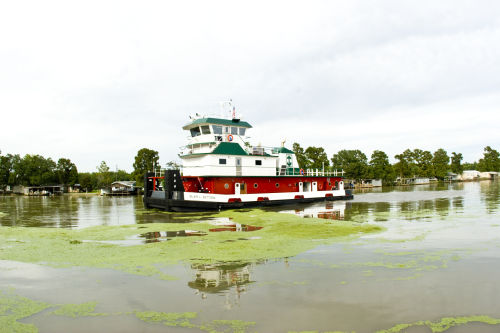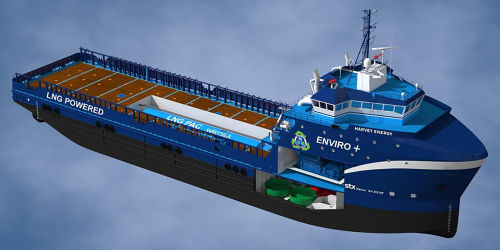
Maritime path charts future course
September 25, 2013
Tradition and ‘dollars on the water’
September 25, 2013Port Fourchon is set to become home to the nation’s first liquefied natural gas fueling facility by February 2014, a milestone that will be satisfied when a New Orleans-based tenant opens the first of two sites capable of holding a combined 540,000 gallons of the cheaper, cleaner-burning fuel, company officials said.
Harvey Gulf International Marine’s installation, divided evenly between two Fourchon slips, is set to coincide with the marine transportation company’s rollout of six LNG-powered offshore supply vessels beginning this year, a fleet that once complete will be the largest in the world to run on the frigid gas, company officials tout.
Coupled with the fuel facility, the fleet is a $400 million Harvey Gulf investment in LNG, nearly a quarter of the $1.7 billion the company has made in capital expenditures since August 2008.
“It’s really interesting to be on the forefront of this,” said Chett Chiasson, executive director of the Greater Lafourche Port Commission. “It will be exciting to see what the future holds for LNG technology and the use of LNG vessels.”
Chiasson said the current demand for LNG as a fuel is lukewarm at the port. Multiple companies, however, have expressed interest in adding LNG-fueled vessels to their fleet.
“There’s just not a huge market for LNG fuel for marine use right now, but that’s something that is on the horizon,” Chiasson said. “It’s coming.”
Natural gas becomes liquefied when it is cooled to about 260 degrees below zero Fahrenheit. In this form it is cheaper and more stable to transport, and it emits less greenhouse gases when burned.
Production of the gas has spiked in the past several years, prompting some in the marine industry to shape their assets around LNG. Domestically, Harvey Gulf, which has an operations office in Galliano, is leading the charge.
Harvey Gulf will install at Fourchon six 90,000-gallon tanks, which are vacuum sealed and encased in an outer shell similar to a Thermos.
The tanks can hold LNG for 80-90 days without a cooling mechanism before the gas vaporizes to the point that pressure levels reach dangerous thresholds, said Chad Verret, Harvey Gulf’s vice president of deep-water development.
To safeguard against severe flood, the reservoirs will be elevated above previous high-water levels and semisubmersible, Verret said. Each tank was designed to store enough gas for one vessel for one month.
The U.S. Coast Guard participated in each phase of facility design, the tanks’ contractor CH-IV International, which specializes in LNG, said.
“We understand what the responsibility of being first means,” Verret said, emphasizing that the company has focused on safety.
Harvey Gulf was founded in 1955. Today, it specializes in towing drilling rigs and providing vessels for deep-water Gulf of Mexico operations. A further indication that now is a watershed moment in its bid to be a major player in Gulf operations, Harvey Gulf announced two weeks ago that it has purchased Golden Meadow-based Abdon Callais Offshore, whose assets include 48 offshore supply vessels.
The company’s LNG-powered fleet of platform supply vessels is under construction at Trinity Shipyard in Gulfport, Miss. The first PSV is scheduled for delivery by the end of the year, and all six will be used out of Port Fourchon.
Three of the 300-foot-long vessels are committed to Shell’s Gulf of Mexico operations. The ships’ 67,000 LNG tanks will be complemented with diesel fuel systems.
Harvey Gulf is also using the fleet to prop its claim as environmentally friendly. Each of the vessels should receive ENVIRO+, Green Passport certification by the American Bureau of Shipping, which requires construction solely from environmentally friendly materials, the installation of advanced alarms for fuel tanks and that a certified environmental officer be on board at all times, among other requirements. Company officials said the ships will be the first offshore supply vessels to achieve this certification.
“These vessels … will meet the highest emissions standards that exist today and even higher standards that haven’t been created yet,” Harvey Gulf CEO Shane Guidry said in a printed statement.
Natural gas is made cheap to American users by its prevalence, as on-land developers have devised a way to extract the gas from shale rock formations beneath Earth’s surface. They do so by injecting undisclosed, proprietary chemicals to crack the formations, a process called hydraulic fracturing and colloquially referred to as fracking.
Although the gas burns cleaner than coal or oil, environmental advocates have said fracking has contaminated neighboring water tables and caused high emission levels of the potent greenhouse gas methane, as well as volatile organic compounds and hazardous air pollutants, at the point of extraction. The EPA, which has reduced its estimate of harmful on-site emissions, is expected to release a draft report next year of a study into whether fracking has impacted drinking water resources.
Production of dry shale gas continues to rise. It neared 30 billion cubic feet per day in May, up from roughly 10 billion cubic feet per day in 2009 and less than 5 billion in 2007, according to the Energy Information Administration.
LNG prices are particularly appealing to U.S. companies. Domestic piped gas costs about $3.60 per one million British thermal units, nearly four times below the $15 per mmBtu Asian countries are paying for imports, according to Reuters. LNG import prices are credited for creating a trade deficit for the first time in 31 years in Japan, the world’s largest importer. LNG’s protracted success could reshape industry expense sheets, drive job growth and create a major trade chip for the nation.
SHELL, ECO PARTNER TO DELIVER LNG FOR GULF OPERATIONS
Galliano-based Edison Chouest Offshore is working with Shell on a partnership to provide LNG as fuel to vessels operating in the Gulf of Mexico, having already agreed to a memorandum of understanding on how to accomplish their goals.
Shell intends to construct an LNG fueling facility in Geismar, tentatively set to open in 2016, where it will also provide fuel for vehicles along the Mississippi River, the Intracoastal Waterway and on-shore oil and gas exploration in Texas and Louisiana.
Edison Chouest Offshore will barge and bunker the fuel, picking it up in Geismar and delivering it from Port Fourchon to customer vessels.
“Natural gas is an abundant and cleaner-burning energy source in North America, and Shell is leveraging its LNG expertise and integrated strength to make LNG a viable fuel option for the commercial market,” Shell Oil Company President Marvin Odum said when the news was announced in March. “We are investing now in the infrastructure that will allow us to bring this innovative and cost-competitive fuel to our customers.”
The Geismar facility is being constructed to hold 250,000 million tons of LNG per year, the company announced. Shell is also transitioning into using LNG as fuel in its own operations.
If completed on schedule, the project could produce the first LNG barging and bunkering operation in North America, company officials said.








